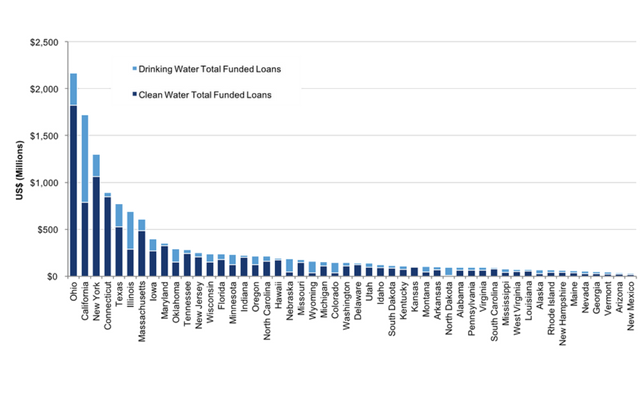New data shows that project requests to fund water and wastewater infrastructure projects through the EPA administered State Revolving Fund (SRF) Program have increased 25% since last year. For the most recent cycle, 2017/2018 fiscal year, US$26.9 billion has been requested for drinking water and another US$55.3 billion for clean water (wastewater), according to new state-by-state project analysis from Bluefield Research.
“Outside of revenue generated from customer billing, the SRF program represents a bedrock source of funding for municipal utilities, reaching almost 20% of their capital expenditure needs,” according to Erin Bonney Casey, Research Director for Bluefield. “Although, the $67 billion difference between requested and awarded funding signals the looming financial challenge for system owners.”
This year, $14.4 billion was committed to SRF loans and grants, which include federal allocations, state matching funds, and state-specific financing programs for water infrastructure projects. Of awarded funds, treatment system projects received the lion’s share- 36% of drinking water projects and 53% of clean water projects. Other types of projects include transmission and distribution networks, sewer collectors and interceptors, water or stormwater storage, water reuse, and stormwater overflow corrections.
Bluefield’s annual analysis of the SRF Program identifies projects and systems that requests these low interest loans and grants to fund capital improvements. The data also demonstrates high variability from state-to-state that is underpinned by more local factors.
State highlights include the following:
- Ohio dominates the funding allocations because it has committed to fund all eligible projects, totaling US$2.2 billion in 2017.
- Illinois issues bonds to augment the available money from state revolving funds.
- Californiaand Texas voted in financing to address drought concerns in 2014 and 2013 respectively, which have boosted the size of SRF resources.
- Select states, such as Tennessee, have not fully matched federal funding, therefore left funding on the table in the short and long-term.
The current program is already oversubscribed, with only 17% of the total requests receiving funding- loans or grants. Further, only a small percentage of municipalities leverage the program. Of the approximate 49,000 drinking water and 18,000 wastewater systems in the U.S., Bluefield has mapped, 3,911 drinking water and 3,730 wastewater systems that have requested funding this fiscal year.
“The noted success of the SRF program has not been overlooked in Washington,” says Ms. Casey. “In light of what else is happening in D.C. to tackle the nation’s infrastructure challenges and roll-backs of EPA regulations, the SRF program has remained intact amid budget reviews and cuts that have impacted other programs.”
About Bluefield Research
Bluefield Research provides data, analysis and insights on global water markets. Executives rely on our water experts to validate their assumptions, address critical questions, and strengthen strategic planning processes. Bluefield works with key decision-makers at municipal utilities, engineering, procurement, & construction firms, technology and equipment suppliers, and investment firms. Learn more.





Comments